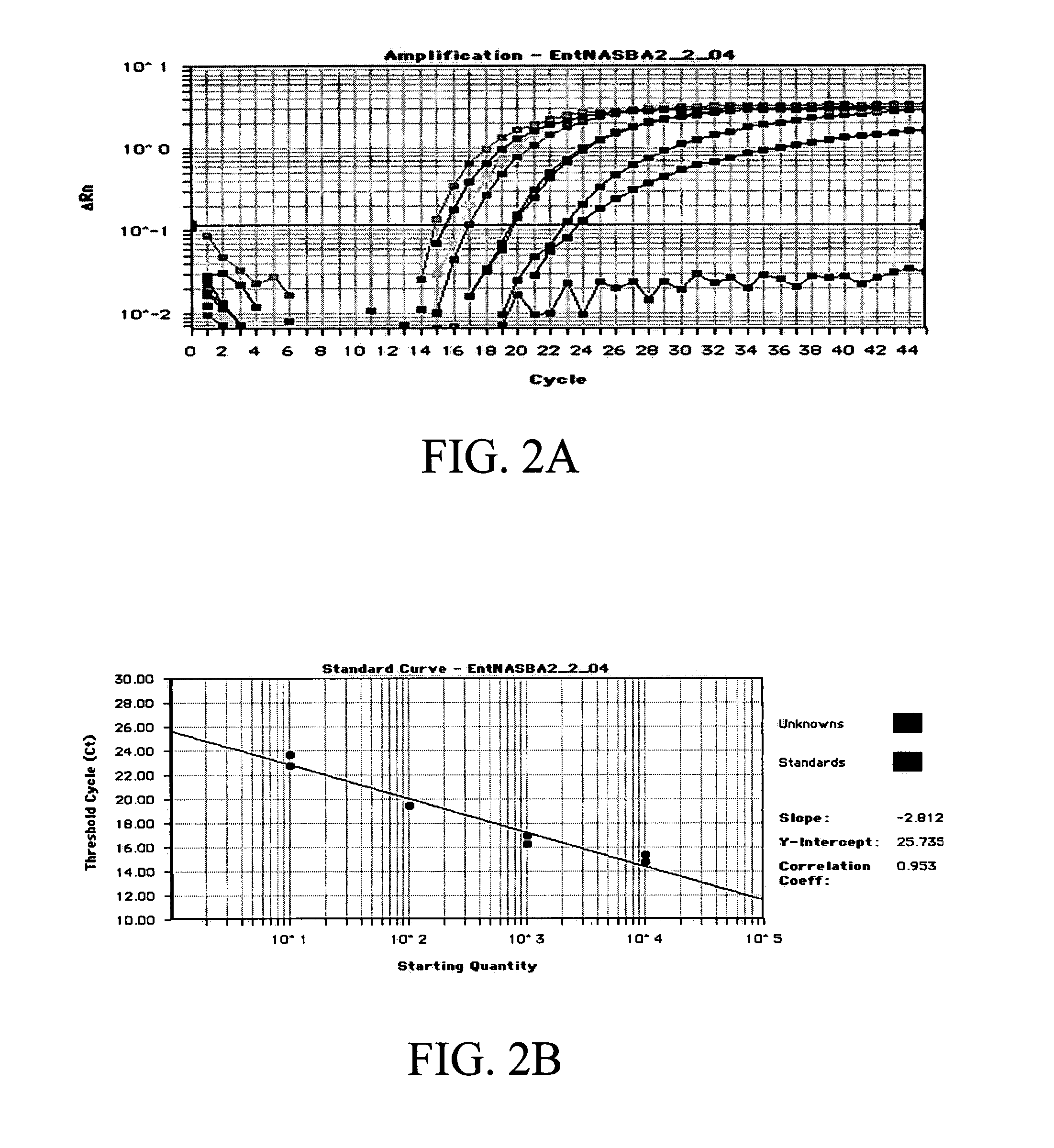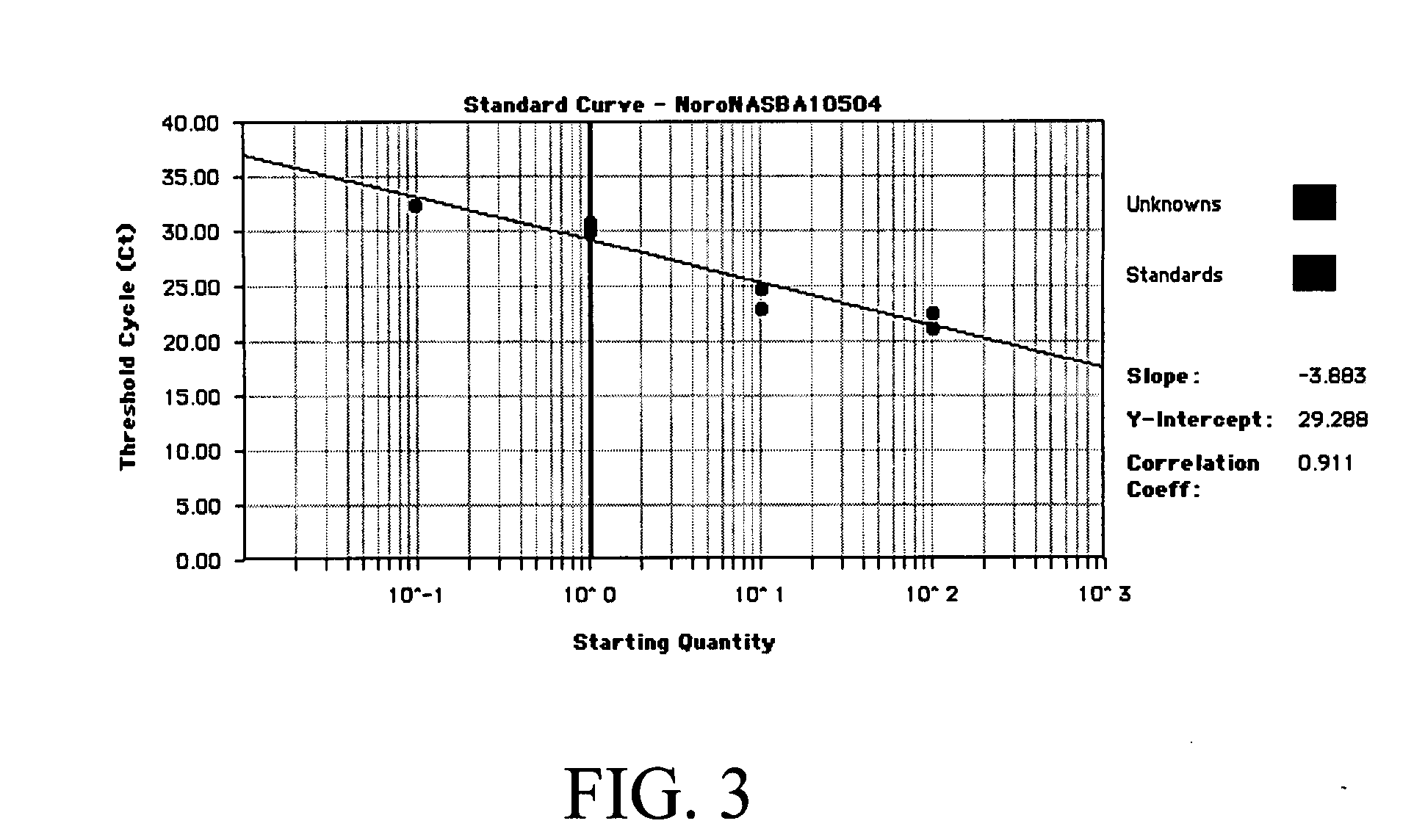Materials and methods for detection of enterovirus and norovirus
a technology of enterovirus and material and method, applied in the field of materials and methods for detection of enterovirus and norovirus, can solve the problems of increased infection risk, children hospitalized and incorrectly treated with antibiotics, and enteric viruses pose serious problems to li
- Summary
- Abstract
- Description
- Claims
- Application Information
AI Technical Summary
Benefits of technology
Problems solved by technology
Method used
Image
Examples
example 1
RNA Extraction and Amplification
[0067] In a preferred embodiment, NASBA technology, in combination with a concentration of the virus, is utilized. This step comprises filtering a desired volume of water (typically approximately 110 liters) by a method such as is known in the art (Filterite filter DFN 0.45-10UN; Filterite / MEMTEC A. Corp., Timonium, Md.; Standard Methods for the Examination of Water and Wastewater, 20th ed., American Public Health Assoc., Washington, DC, 1998). Viruses are eluted with beef extract (pH 9.5) and concentrated using organic flocculation. As an alternative, the water can be filtered using vortex flow filtration (Paul, J. H. et al. Appl. Environ. Microbiol. 1991 57:2197-204. Concentration of viruses and dissolved DNA from aquatic environments by vortex flow filtration). The viral concentrate or standard poliovirus, for example, is stored at −20° C. until extraction.
[0068] Extraction is accomplished by taking a desired amount of the concentrate or enterovi...
example 2
Methods to Detect and Quantitate Enteroviruses and Noroviruses by Real Time Nucleic Acid Sequence Based Amplification (NASBA)
[0076] This method has been developed to detect enteroviruses and genogroup II noroviruses from environmental samples. Environmental samples can be fresh or saline waters, surfaces, and stool samples. The methods should also be appropriate for clinical samples (blood, urine, cerebrospinal fluid, etc.)
[0077] A. Extraction of Viral RNA from Aqueous Samples
[0078] If samples are suspected to have high concentrations of viruses (e.g., raw sewage, wastewater, septage), then there is no need to concentrate. For concentration from seawater, a modified method of Katayama, H. et al. (Appl. Environ. Microbiol., 2002, 68(3):1033-1039) is recommended.
[0079] B. Collection of Enteroviruses and Noroviruses from Seawater [0080] 1. Collect 500-1000 ml of the seawater to be tested (if larger volumes are to be sampled, increase the diameter of the filter and the filtration ma...
example 3
Quantitative Detection of Enteroviruses by Real Time NASBA using an internal control (IC-NASBA)
[0134] Because of the three enzymes involved in NASBA, each with their different kinetics, the time to positivity (TTP) approach taken in Quantitative (Real-Time) PCR does not provide ideal standard curves with NASBA. Data sets typically have reaction kinetics that do not easily lend themselves to a simple threshold cycle (Ct) analysis. This results in standard curves with lower coefficients of determination (r2=0.7-0.8) for NASBA compared to those for Real-Time PCR (typically >0.95).
[0135] The present inventors have designed a specific internal control containing a different beacon hybridization site. Thus, the same amplification primers are used for both the calibrator and the target mRNA. However, a second molecular beacon containing a different fluor (6-ROX) is used, which hybridizes to the unique internal site in the calibrator molecule (FIG. 4). The amplification of both the calibr...
PUM
| Property | Measurement | Unit |
|---|---|---|
| volume | aaaaa | aaaaa |
| pH | aaaaa | aaaaa |
| volumes | aaaaa | aaaaa |
Abstract
Description
Claims
Application Information
 Login to View More
Login to View More - R&D
- Intellectual Property
- Life Sciences
- Materials
- Tech Scout
- Unparalleled Data Quality
- Higher Quality Content
- 60% Fewer Hallucinations
Browse by: Latest US Patents, China's latest patents, Technical Efficacy Thesaurus, Application Domain, Technology Topic, Popular Technical Reports.
© 2025 PatSnap. All rights reserved.Legal|Privacy policy|Modern Slavery Act Transparency Statement|Sitemap|About US| Contact US: help@patsnap.com



